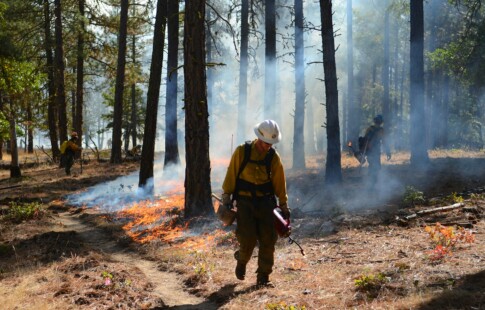
The Ultimate California National Park Road Trip
We are reader-supported. When you buy through links on our site, we may earn affiliate commission.
Boasting more national parks than any other U.S. state, it’s safe to say that California is an epic place to take a national park road trip. The parks vary so much in climate, wildlife and terrain that you might as well be visiting different countries. This guide will cover the first seven locations from north to south, and then head west to make a loop as you hit the last two parks. The ideal time to do it is in autumn.
1. Redwood National Park
This gorgeous redwood ecosystem is home to bears, elk and some unexpectedly charismatic invertebrates, like banana slugs. Heavily forested, the national park connects to Prairie Creek Redwoods, Del Norte Coast Redwoods and Jedediah Smith Redwoods State Parks. They’re all free to enter, although some areas require you to pay a small fee for a day-use pass. This helps fund park maintenance and wildlife conservation.
- Entrance fee: $0
- Best hiking trails: Because the state and national parks are connected, this list includes trails from the state parks as well, and some may require day-use passes. Some of the best hiking trails in the region include Ladybird Johnson Grove Loop, Fern Canyon, Trillium Falls and the James Irvine Trail.
- Best wheelchair-accessible trails: None in the national park, but the adjacent state parks have several. This includes the Simpson-Reed Grove, Leiffer Loop, Big-Tree Wayside, Elk Prairie Trail, Revelation Trail and the Karl Knapp (Prairie Creek) to Foothills Trail Loop.
- Other things to know: Be prepared for cool, damp weather at any time of the year.
2. Lassen Volcanic National Park
Featuring lakes, forest groves and open meadows, the next stop on your national park road trip is Lassen Volcanic National Park. The park gets its name from Lassen Peak, one of only two volcanoes — the other being Mount St. Helens — to erupt in the contiguous U.S. during the 20th century. Active thermal features dot the landscape. In fact, it looks a lot like Yellowstone without the massive crowds.
- Entrance fee: $30 for a seven-day vehicle pass
- Best hiking trails: Manzanita Lake Loop, Lassen Peak, Cinder Cone Trail, Bumpass Hell
- Best wheelchair-accessible trails: Geologic Walk Through Time, Devastated Area, Sulphur Works
- Other things to know: Thanks to conservation efforts in Oregon, a wolf pack lives in the forest surrounding this national park.
3. Yosemite National Park
This is one of the world’s most famous camping and hiking destinations. Nestled in the Sierra Nevada Mountains, Yosemite is known for its jaw-dropping scenery that has inspired countless generations of writers and conservationists. Aim to arrive at the park very early in the morning to beat the crowds — millions of people visit every year.
- Entrance fee: $35 for a seven-day vehicle pass
- Best hiking trails: Yosemite Falls, Mist Trail, Mirror Lake, Bridalveil Fall, Lyell Canyon
- Best wheelchair-accessible trails: Yosemite is very wheelchair accessible overall. Some of the best trails include Mirror Lake, Cook’s Meadow Loop, most of Lower Yosemite Fall Trail and numerous paved bike trails.
- Other things to know: The park gets extremely busy between March to October, so consider leaving your car in a designated parking area and taking the free shuttle to explore the valley.
4. Kings Canyon National Park
This park is conjoined with Sequoia National Park to form an area of breathtaking beauty. Rugged mountains, cold rivers and giant sequoia trees characterize the area. Both the John Muir Trail and Pacific Crest Trail pass through Kings Canyon National Park.
- Entrance fee: $35 for a seven-day vehicle pass, which also gets you into Sequoia National Park
- Best hiking trails: Mist Falls, Rae Lakes Loop, Paradise Valley, Zumwalt Meadow
- Best wheelchair-accessible trails: Grant Tree Trail, Panoramic Point Overlook
- Other things to know: Kings Canyon has limited services and places to stay, so it’s one of the least-visited parks in the Sierras.
5. Sequoia National Park
This park contains Mount Whitney, the highest point in the contiguous United States. It also has the world’s largest single-stem tree — the General Sherman tree — which is a sequoia that attracts many sightseers. Sequoia National Park is a great place to go hiking or camping during your national park road trip. Or, you can simply take in the amazing views from the road.
- Entrance fee: $35 for a seven-day vehicle pass, which also gets you into Kings Canyon National Park
- Best hiking trails: Tokopah Falls, Moro Rock, Crescent Meadow, Crystal Cave
- Best wheelchair-accessible trails: General Sherman, Tunnel Log, Big Trees Trail
- Other things to know: No reservations are required to enter Sequoia or Kings Canyon National Parks. As with many other national parks, cell phone service is unreliable in several areas.
6. Death Valley National Park
A land of extremes, Death Valley is the hottest place on earth, as well as the driest and lowest part of the United States. Its martian landscape features bright white salt flats, sand dunes, badlands and jagged purple mountains. Most people visit in the fall and winter. Despite the harsh conditions, many animals call this place home, including coyotes, bighorn sheep and the Death Valley pupfish.
- Entrance fee: $30 for a seven-day vehicle pass
- Best hiking trails: Mosaic Canyon, Zabriskie Point, Mesquite Flat Sand Dunes
- Best wheelchair-accessible trails: Badwater Basin Salt Flats, Salt Creek Interpretive Trail, Harmony Borax Works
- Other things to know: Get off the trails by 10:00 a.m. at the latest to avoid suffering heat stroke or severe dehydration.
7. Joshua Tree National Park
Joshua Tree National Park gets its name from the spiky, tree-like yucca plants that proliferate in the alien landscape. As with Death Valley, most people visit in the fall and winter to avoid the extreme heat, although early spring also sees some visitors. Prepare for unpredictable weather and carry lots of water as you traverse this scenic desert park.
- Entrance fee: $30 for a seven-day vehicle pass
- Best hiking trails: Arch Rock Trail, Ryan Mountain, Hidden Valley, Barker Dam
- Best wheelchair-accessible trails: Oasis of Mara Trail, Lower Keys View Overlook
- Other things to know: Most of the park has no cell service. You can get Wi-Fi at the Oasis Visitor Center, Twentynine Palms and Joshua Tree Visitor Center.
8. Channel Islands National Park
This park features five islands off the coast of California. Numerous sea caves attract kayakers, and other popular activities include scuba diving, hiking and fishing. Look for whales and sea lions in the surf, or explore onshore habitats that include blooming wildflowers in the winter and spring.
- Entrance fee: $0
- Best hiking trails: Potato Harbor, Cavern Point Loop, Smuggler’s Cove, Scorpion Canyon
- Best wheelchair-accessible trails: Due to the rugged, sandy terrain and hard-to-access nature of the islands, there are no wheelchair-accessible trails.
- Other things to know: You’ll need to brush your boots thoroughly to remove any seeds or fungal spores before departing the mainland. This prevents the spread of invasive species in the sensitive habitat of the Channel Islands.
9. Pinnacles National Park
You could be forgiven if you haven’t heard of Pinnacles National Park, as it only achieved national park status in 2013. Due to the scorching hot summers, most people visit in the spring or fall. The majority of the park is a designated wilderness area. Keep an eye out — if you’re lucky, you might see a mountain lion, pronghorn or even a rare California condor in this rocky, forested area, and you can explore talus caves to look for bats.
- Entrance fee: $30 for a seven-day vehicle pass
- Best hiking trails: Balconies Cave Trail, Old Pinnacles Loop, High Peaks, Moses Spring to Bear Gulch Reservoir
- Best wheelchair-accessible trails: Bench Trail, Prewett Point Trail
- Other things to know: There isn’t a road that traverses the entire park, so you’ll need to decide whether you’ll come in through the east or west entrance. The east side is farther from the highway and services like gas stations and restaurants, but there’s more to do on the park’s east side.
A National Park Road Trip Like No Other
California might be the perfect place to go sightseeing, camping and hiking if you’re planning a road trip. With spectacular biodiversity and unforgettable views, there’s something for everyone in the Golden State’s nine national parks.
Share on
Like what you read? Join other Environment.co readers!
Get the latest updates on our planet by subscribing to the Environment.co newsletter!
About the author

Steve Russell
Steve is the Managing Editor of Environment.co and regularly contributes articles related to wildlife, biodiversity, and recycling. His passions include wildlife photography and bird watching.





